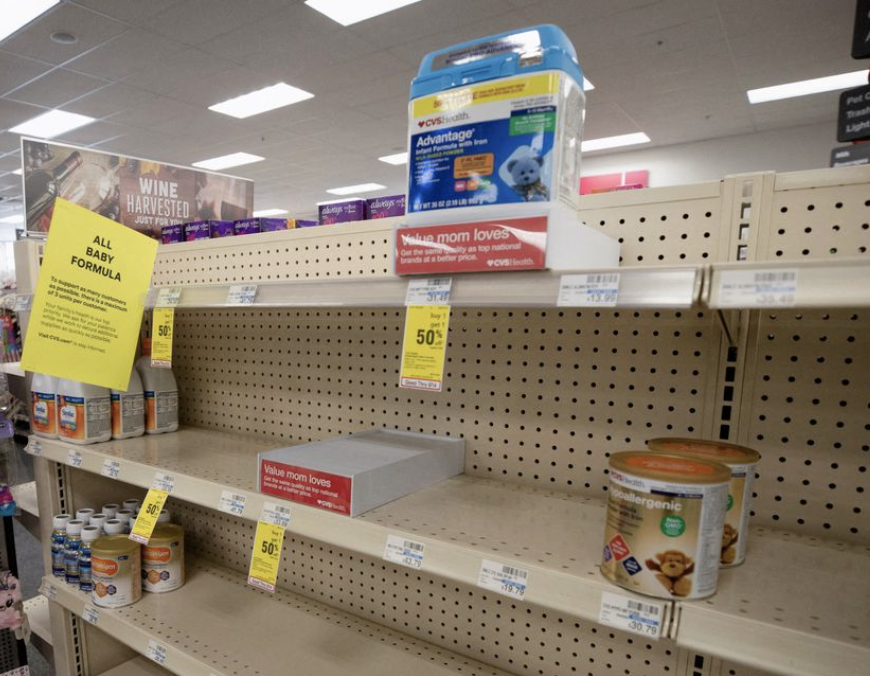By: The Editorial Board – wsj.com – May 16, 2022
By now you’ve heard that some 40% of the nation’s baby formula is out of stock, causing new mothers to hunt from store to store to feed their infants. This should never happen in America. How did it? Here’s the government part of the story you won’t hear from the political class.
Abbott Laboratories in February recalled several brands and shut down a plant in Michigan after complaints that four infants fell severely ill with a dangerous bacteria after ingesting its powdered formula. The Food and Drug Administration launched an investigation and onsite inspection, noting earlier findings that had detected the bacteria at the plant.
It’s not clear when the FDA was made aware of the problems at the plant and why it didn’t take action sooner. Abbott said this week that “after a thorough review of all available data, there is no evidence to link our formulas to these infant illnesses.” The FDA said Friday the Centers for Disease Control and Prevention closed its investigation after finding no more cases of infant illness.
Some conservatives blame the FDA for causing a scare, but the agency had no choice but to investigate the complaints and warn consumers. The real culprit is government policies that have limited formula options.
Last year Abbott accounted for 42% of the U.S. formula market, about 95% of which is produced domestically. There are only four major manufacturers of formula in the U.S. today: Mead Johnson, Abbott, Nestle,and Perrigo. One reason the market is so concentrated is tariffs up to 17.5% on imports, which protect domestic producers from foreign competition. Non-trade barriers such as FDA labeling and ingredient requirements also limit imports even during shortages.
Canada’s strong dairy industry has attracted investment in formula production. But the Trump Administration sought to protect domestic producers by imposing quotas and tariffs on Canadian imports in the USMCA trade deal. The FDA can inspect foreign plants so the U.S. import restrictions aren’t essential for product safety. They merely raise prices for consumers and limit choice.
Further limiting competition is the Special Supplemental Nutrition Program for Women, Infants, and Children (WIC) for low-income mothers. By the Department of Agriculture’s estimate, WIC accounted for between 57% and 68% of all infant formula sold in the U.S. Under the welfare program, each state awards an exclusive formula contract to a manufacturer.
Companies compete for the contracts by offering states huge rebates on the formula women can buy. The rebates equal about 85% of the wholesale cost, according to a 2011 USDA study. Women can only use WIC vouchers to purchase formula from the winning manufacturer. These rebates reduce state spending, but there’s no such thing as free baby formula.
Why would manufacturers give states an enormous discount? Because the contracts effectively give them a state monopoly. Stores give WIC brands more shelf space. Physicians may also be more likely to recommend WIC brands. After 30 states switched their WIC contracts between 2005 and 2008, the new provider’s market share increased on average by 84 percentage points.
***
America’s baby-formula shortage illustrates how bigger government can make big business bigger, thereby limiting competition and choice. This is especially worth noting as Democrats push to expand entitlements and government control over the private economy with Medicare for All, free child care, universal pre-K and more.
It also illustrates that global trade has its uses, and there are costs to the faddish drive to produce everything in America. Members of both parties in Congress want to subsidize domestic production, but this can create its own supply-chain vulnerabilities. Globalization nowadays may be a dirty word, but having diverse suppliers is an economic strength.
To see this article and subscribe to others like it, choose to read more.
 Listen Online
Listen Online Watch Online
Watch Online Find a Station in Your Area
Find a Station in Your Area








 Listen Now
Listen Now Watch Online
Watch Online
